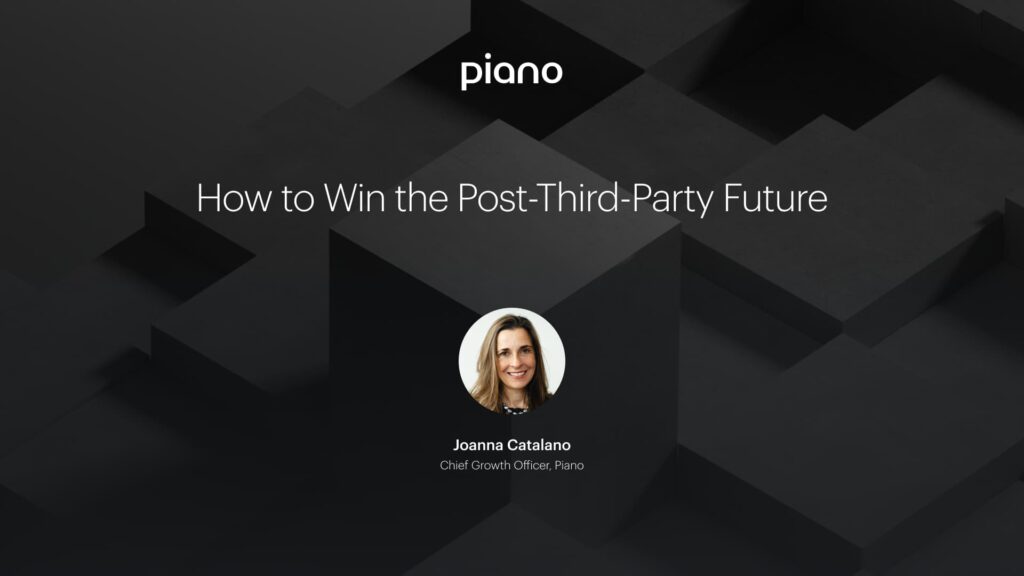Post-Third-Party Cookie Identity from All Sides: A Roundtable
We recently announced new addressability partnerships with industry leaders in identity, collaborative data solutions and consent as we enhance our First-Party Data Acquisition solution, which integrates its data management, identity and customer journey orchestration capabilities. Back in March as part of Piano Academy, we spoke with one of these partners, LiveRamp, in addition to OpenSlate to understand the consequences and opportunities surrounding third-party cookie deprecation. What the panelists unanimously agreed on was that the removal of this legacy technology and some of our practices around it will help build a better open Internet. Read on to get more insights from the panel.
Both buy and sell side need to be planning now
When Google first announced their plan to retire third-party cookies from Chrome in January of 2020, we were, quite literally, living in a different world. When COVID-19 began its global spread, publishers and brands had to focus on how to keep their businesses afloat and their employees safe. Preparing for an event two years away was not the top priority.
Fast-forward to a year later as the world is slowly beginning to open up, and many publishers and brands are realizing the impact of the time they lost in planning for the “what next” just nine months before third-party cookies are set to become extinct.
“I think that what we've seen are brands and marketers starting to realize that there is a need to quickly catch up and start to investigate,” said Jason Wolfson, Piano’s VP of Product Marketing. “We saw that at the end of last year, and I think it probably started six months later than we expected.”
On the publisher side, “I think that there now is kind of the ‘oh no’ moment of realizing that we need to start accounting for this and actually be able to be set up for success, not just in six months, not in 12 months, but for the longevity of the business to make sure that we're as healthy as possible.”
Travis Clinger, SVP of Addressability and Ecosystem at LiveRamp, agreed, noting that it is only recently that the industry started realizing how big of a change this is — despite 40% of the internet already lacking third-party cookies — and that it involves far more than just having access to first-party data and data-management tools (though those things certainly help).
“And over time, I think both marketers and publishers have really started to dive in and say, "No, on a publisher side, this affects the majority of my revenue. Most of my inventory is made worse. The higher CPMs are my inventory. I have a cookie but, when I don't, my CPM drops by 60%, according to Google."
Even with the best-laid plans, the timing of their execution could run up against the holiday season, which “is not the time to be making tweaks to your cookie strategy, your identity strategy, putting new code on pages and testing new vendors,” Clinger added.
“So really, marketers and publishers have six months before they enter the holiday season, and they need to be fully transitioned off the [third-party] cookie or using both the discovery cookie and a post-cookie solution in that time and be ready to go.”
Solutions abound — test across them to find the right one
From Google’s FLoC to hashed emails and first-party data strategies, there are many solutions to third-party cookie deprecation to explore regardless of what side of the ecosystem you sit on. A lot of marketers are looking to contextual advertising as one solution, said Andrew Smith, Chief Product Officer at OpenSlate, which are effectively probabilistic when it comes to matching the content to a user.
“There's also a lot of interesting options to have contextual interplay with a publisher's first-party data strategy, which is something that, personally, I've given a lot of advice on,” he said. “So there's a lot of tactics out there. And there's a lot of interest from marketers to work with the supply side and providers like ourselves to come up with solutions that allow for sort of a post-cookie solution. I think that, if anything, there's an overall industry momentum that's moving forward to solve this challenge as things become either siloed or potentially more difficult to rely on old methodologies.”
For those leaning towards a first-party data strategy, you need to first understand how much of that type of data you are collecting today and how you can collect more of it by providing the right incentives to your customers. Then, can you actually store that data and the consent provided from your users? And then it becomes how to take users from unknown to known using the right technological approaches like segmentation and lookalike modeling and partners like identity providers.
There is no need to wait to activate potential solutions, said LiveRamp’s Clinger.
“There are contextual solutions that work today; there are authenticated solutions that work today. You can start buying inventory; you can start measuring it, and you can start rolling it out on your market. So you don't have to go from all cookie to all cookieless overnight. It is a transition phase.”
Piano’s Cookieless Survival Kit includes helpful tips and terminology for publishers looking to harness more of their first-party data as a solution for third-party cookie deprecation.
Rebuilding consumer trust with value exchange
What third-party cookie deprecation really comes down to is rooted in the fact that publishers, marketers and tech companies need to be building better relationships with consumers.
“I think that trust and consent are really at the core of everything that we need to do moving forward,” said Wolfson. “I think that many consumers distrust ad tech and...there's also distrust within ad tech itself. So the key between looking at authenticated versus unauthenticated is really rooted in having that respect for privacy, and making sure that we are thinking about consent and the tools needed to do that.”
Authenticating users engenders trust, privacy and that ultimate personalized experience, he said. In return, it gives marketers and publishers the ability to optimize for conversion or monetization. Whether unauthenticated or authenticated, though, we have to make sure that solutions really lean into the consumer dialogue and restore that trust, especially when you consider that only about 30% of total internet traffic will be authenticated by the time third-party cookies are deprecated, Clinger said.
“As an industry, we have to reject other solutions and say, we're going to focus on authenticity, and we're going to focus on scalable solutions that also put the consumer first instead of thinking of the marketer, or the publisher, as our primary user. We always have to think of the consumer first as we're building products.
“You know there's also an opportunity here for publishers to be more front and center when it comes to having that dialogue and owning some of the conversation with marketers. And I think that means a closer relationship with brands and sellers of advertising and with publishers, which is a good thing. Hopefully, the net result is that the end customer, which is really the publisher's bread and butter, is protected. And that there's a value exchange and a relationship built upon trust.”
Watch the rest of the video from Piano Academy above to hear more insights and tips for tackling third-party cookie deprecation.




